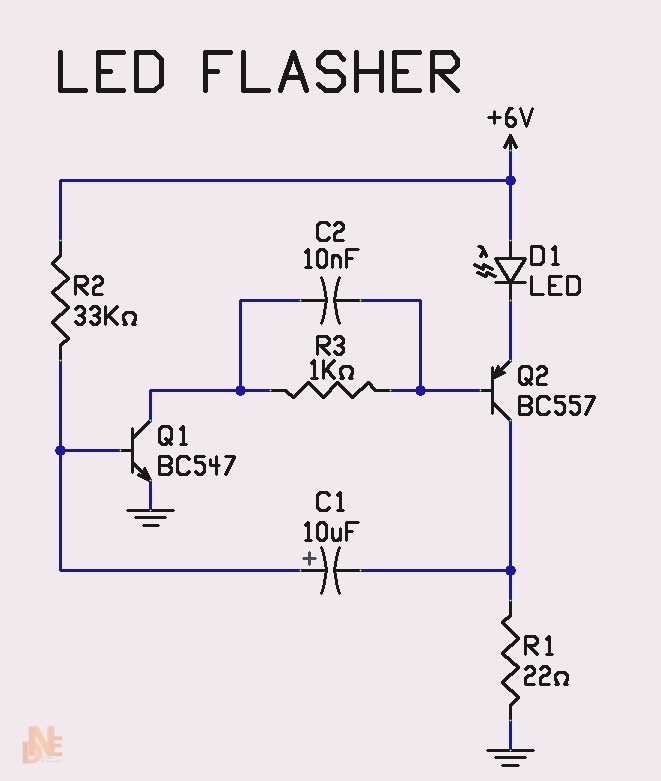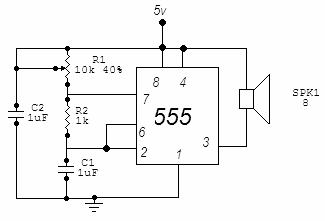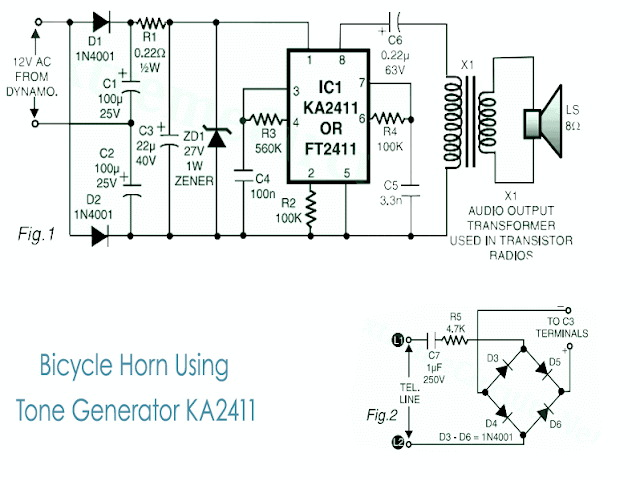Tone generator circuit
in
555,
Electronic-Circuits
- on 10:45
Simple, low component count tone generator. It can be adapted to create a morse code circuit, by adding a switch to the output.
How it works:
This circuit is based around the 555 timer circuit, used as an astable (free running) oscillator. The frequency (pitch) of the tone is set by the resistors and capacitors in the left side of the circuit. The first one is a potentiometer (variable resistor), this is our pitch control, which is basically all the external components you need. The capacitor to the far left is to reduce as much noise or undesired operation of the potentiometer, getting a smooth pitch change when adjusting.
=====================================================================
If u have any doubts please comment below, will respond as soon as possible
Luxurious Toilet Bathroom Controller
in
Electronic-Circuits,
Mini-Project,
Power-Electronics
- on 22:55
Smart controller for your toilet and bathroom. The light and fan will automatic on when someone entere toilet or bathroom and off when no person inside it.
Aged persons in the house and guests often fumble while searching for the toilet and bathroom switches at night. Also, very few of us take care to switch off the lights of toilets/bathrooms after using them. The circuit given here helps to overcome both the problems. The figure shows two symmetrical circuits (one each for toilet and bathroom) sharing common power supply and a melody generator-cum-audio warning unit. The reed switches S1 and S2 are of normally-open type, operated by permanent magnets appropriately fixed to the doors of bathroom and toilet, respectively. When the doors of bathroom and toilet are closed, the reed switches are also closed, and vice versa. (Door is assumed in closed condition with nobody inside bathroom/toilet, i.e. reed switch is activated.)
The operational features of the circuit are:
Simultaneously, pin 2 (Q) of IC1(a) goes low, switching transistor T5 ‘on’, which switches on melody generator IC4, letting out a sweet audio tune via transistor T6 and loudspeaker. In normal condition, when someone opens the bathroom door and gets inside within preset time of IC3(a) (10 seconds here), and closes the door from inside, the music stops with lamp and fan ‘on’. Now, in case someone opens the door before or after use, and forgets to shut it, the lamp and exhaust fan are switched off after 10 seconds but the music remains ‘on’ as a reminder that the door is to be closed.
This happens due to mono multivibrator (MMV) IC3(a), which resets pin 10 of IC1(b) through transistor T1 after 10 seconds. (This period can be adjusted by varying the values of resistor R11 and/or capacitor C7.) It should be noted here that although IC3 is used as ‘MMV’, it is triggered here with a positive pulse through its pin 4 (reset pin) rather than its pin 6 (trigger pin). This arrangement makes it unique for setting and resetting IC3 through pin 4, and resetting IC1(a) through pin 5 of IC3 and transistor T1. Battery backup facility ensures memory backup during power failure. Power supply uses a normal 2-diode full-wave rectifier circuit, which needs no further explanation.
The purpose of using bi-color LED1 and LED2 is that, initially when the door is closed these emit green light— as the green LED part gets the supply via resistor R15— to indicate that bathroom/toilet is vacant. When bathroom/toilet is occupied, transistor T3/T4 conduct to light up the red LED part as well. Melody generator IC4 (UM66) is switched on through diodes D3/D4 and transistor T5, which conducts when IC1(a) pin 2 or IC2(a) pin 2 goes low. When transistor T5 conducts, zener ZD1 breaks down and supplies regulated 3.9V to IC4, to produce a melodious tune via transistor T6 and the speaker. As most toilets and bathrooms are ‘attached’ nowadays, only a single circuit is required, and the circuit can be wired on a general-purpose veroboard. A small modification of the circuit, by adding additional SPST switch S3, as shown in Fig. 2, needs to be done inside the wooden switchboard box. This permits the user to operate the lamp and fan during cleaning of the toilet or for bypassing the circuit, when bathroom or toilet undergo repair work.
Aged persons in the house and guests often fumble while searching for the toilet and bathroom switches at night. Also, very few of us take care to switch off the lights of toilets/bathrooms after using them. The circuit given here helps to overcome both the problems. The figure shows two symmetrical circuits (one each for toilet and bathroom) sharing common power supply and a melody generator-cum-audio warning unit. The reed switches S1 and S2 are of normally-open type, operated by permanent magnets appropriately fixed to the doors of bathroom and toilet, respectively. When the doors of bathroom and toilet are closed, the reed switches are also closed, and vice versa. (Door is assumed in closed condition with nobody inside bathroom/toilet, i.e. reed switch is activated.)
The operational features of the circuit are:
- Lamp and exhaust fan are switched on when the door is opened.
- Soft music is played continuously until the door is closed from inside/out side.
- With a person inside the room, lamp and fan remain on, until the door is reopened. They go off when the door is reopened.
- Visual indication of whether the toilet/bathroom is occupied/vacant is given by two bicolour LEDs fixed on a panel, which may be fitted near the door with corresponding ‘toilet’/’bathroom’ labels on them. Here the LED colour turns from ‘green’ to ‘red’ if the room gets occupied, and vice-versa.
- If the door is opened once, and not closed back within 10 seconds, the lamp and fan are automatically switched off, thus conserving electricity. But the music remains on as a reminder that the door is not closed.
- For cleaning of bathroom/toilet with doors kept open, a parallel on/off switch is included on the switchboard to bypass the relay contacts and manually control the switching on/off of the light and exhaust fan. (This is the service mode.) In this case, the music remains on as long as the door remains open. In case of failure of the unit, the same on/off switch can be used as usual until the circuit is repaired.
- Due to battery backup facility, even with power failure, when a person is inside, the door status is maintained. However, the lamp and fan will be on only on mains resumption.
- Also, when a person leaves the room during power failure, with door closed, the lamp and fan are kept off on resumption of power. (Intelligent-mode!)
- However, the circuit can be fooled by opening and closing the door within 10 seconds, without entering inside. In this case, the lamp and fan will continue to be on and would require reopening and closing of the door to bring the circuit to order.
Simultaneously, pin 2 (Q) of IC1(a) goes low, switching transistor T5 ‘on’, which switches on melody generator IC4, letting out a sweet audio tune via transistor T6 and loudspeaker. In normal condition, when someone opens the bathroom door and gets inside within preset time of IC3(a) (10 seconds here), and closes the door from inside, the music stops with lamp and fan ‘on’. Now, in case someone opens the door before or after use, and forgets to shut it, the lamp and exhaust fan are switched off after 10 seconds but the music remains ‘on’ as a reminder that the door is to be closed.
This happens due to mono multivibrator (MMV) IC3(a), which resets pin 10 of IC1(b) through transistor T1 after 10 seconds. (This period can be adjusted by varying the values of resistor R11 and/or capacitor C7.) It should be noted here that although IC3 is used as ‘MMV’, it is triggered here with a positive pulse through its pin 4 (reset pin) rather than its pin 6 (trigger pin). This arrangement makes it unique for setting and resetting IC3 through pin 4, and resetting IC1(a) through pin 5 of IC3 and transistor T1. Battery backup facility ensures memory backup during power failure. Power supply uses a normal 2-diode full-wave rectifier circuit, which needs no further explanation.
The purpose of using bi-color LED1 and LED2 is that, initially when the door is closed these emit green light— as the green LED part gets the supply via resistor R15— to indicate that bathroom/toilet is vacant. When bathroom/toilet is occupied, transistor T3/T4 conduct to light up the red LED part as well. Melody generator IC4 (UM66) is switched on through diodes D3/D4 and transistor T5, which conducts when IC1(a) pin 2 or IC2(a) pin 2 goes low. When transistor T5 conducts, zener ZD1 breaks down and supplies regulated 3.9V to IC4, to produce a melodious tune via transistor T6 and the speaker. As most toilets and bathrooms are ‘attached’ nowadays, only a single circuit is required, and the circuit can be wired on a general-purpose veroboard. A small modification of the circuit, by adding additional SPST switch S3, as shown in Fig. 2, needs to be done inside the wooden switchboard box. This permits the user to operate the lamp and fan during cleaning of the toilet or for bypassing the circuit, when bathroom or toilet undergo repair work.
Bicycle Horn Using Tone Generator KA2411
in
Electronic-Circuits,
KA2411,
Mini-Project
- on 22:12
An interesting circuit of a bicycle horn based on a popular, low cost telecom ringer chip is described here. This circuit can be powered using the bicycle dynamo supply and does not require batteries, which need to be replaced frequently. The section comprising diodes (D1 and D2) and capacitors (C1 and C2) forms a half-wave voltage-doubler circuit. The output of the voltage doubler is fed to capacitor C3 via resistor R1. The maximum DC supply that can be applied to the input terminals of IC1 is 28V. Therefore zener diode ZD1 is added to the circuit for protection and voltage regulation. The remainder of the circuit is the tone generator based on IC1 (KA2411).
The dual-tone output signal from pin 8 of IC1 is fed to the primary of transformer X1 (same as used in transistor radios) via capacitor C6. The secondary of X1 is connected to a loudspeaker directly. In case you are interested in connecting a piezoceramic element in place of the loudspeaker, remove capacitor C6, transformer X1, and the loudspeaker. Connect one end of the piezoceramic disk to pin 5 of IC1 and the other end to pin 8 of IC1 through a 1/4W, 1-kiloohm resistor. IC1 KA2411 is also available in COB style, with the same pin configuration. Both packages work equally well.
However, to get the best results with the COB package, change values of resistors R2 through R4 to 330-kilo-ohm, capacitor C4 to 0.47µF, 63V electrolytic (positive end to pin 3 of IC1), and C5 to 0.005µF, 63V. This bicycle horn project can also be used as a telephone extra ringer by just removing all components on the left side of capacitor C3 and connecting the circuit shown in Fig. 2 to the terminals of capacitor C3.
Electronics 20l5 IEEE Seminar abstracts : IMPROVED SENSORLESS CONTROL SYSTEM
in
Electronics-Seminar,
Seminars
- on 23:05
AN IMPROVED SENSORLESS CONTROL
SYSTEM OF PERMANENT MAGNET SYNCHRONOUS MOTOR
To improve the performance of
permanent magnet synchronous motor sensor less control system, the phase offset
caused by the low pass filter must be considering. In this paper, to apply
the linear control theory to PMSM system. The introduced control strategy is based
on reduced-order observer and adaptive velocity estimation, then proposed a
method to compensate the phase offset by group time delay. With proper pole
locations of the observer, stability of the position estimation is guaranteed,
and stability of the adaptive velocity estimation is also guaranteed by Popov's
hyper stability theory. The effectiveness of the method is verified through the
SIMULINK modeling and simulation.
Published in:
Date of
Conference:
16-17 Jan. 2013
Page(s):
206 - 208
Print ISBN:
978-1-4673-5652-7
INSPEC Accession
Number:
13474956
Conference
Location :
Hong Kong
Digital Object
Identifier :
Publisher:
IEEE


















